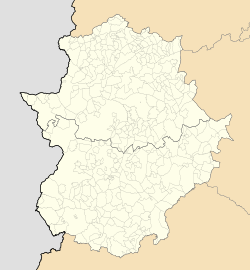You can help expand this article with text translated from the corresponding article in Spanish. (December 2009)Click [show] for important translation instructions.
|
Castilblanco | |
|---|---|
| Coordinates: 39°17′06″N05°05′26″W / 39.28500°N 5.09056°W | |
| Country | |
| Autonomous community | |
| Province | Badajoz |
| Founded | 12th century |
| Government | |
| • Type | Mayor–council |
| • Body | Ayuntamiento de Castilblanco |
| • Mayor | Rafael Delgado (PSOE) |
| Area | |
• Total | 1,316 km2 (508 sq mi) |
| Elevation | 501 m (1,644 ft) |
| Population (2018) [1] | |
• Total | 972 |
| • Density | 0.74/km2 (1.9/sq mi) |
| Demonym(s) | castilblanqueño (m), castilblanqueña (f) |
| Time zone | UTC+1 (CET) |
| • Summer (DST) | UTC+2 (CEST) |
| Postal code | 06680 |
| Website | www.castilblanco.es |
Castilblanco is a municipality located in the province of Badajoz, Extremadura, Spain. According to the 2005 census (INE), the municipality has a population of 1146 inhabitants.



